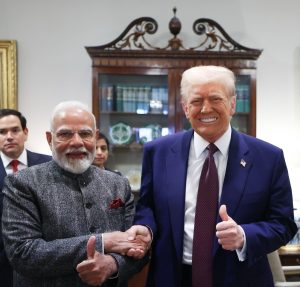Indian Prime Minister Narendra Modi’s recent visit to Washington to meet with U.S. President Donald Trump has raised eyebrows in Islamabad.
In the joint statement issued during Modi’s trip, the two leaders “called on Pakistan to expeditiously bring to justice the perpetrators of the 26/11 Mumbai, and Pathankot attacks and ensure that its territory is not used to carry out cross-border terrorist attacks.”
Responding to the “Pakistan-specific reference” in the joint statement, Pakistan’s Foreign Office spokesperson Shafqat Ali Khan said that Pakistan considered this “as one-sided, misleading and contrary to diplomatic norms.” Khan said that it was surprising that this issue was even mentioned, given Pakistan’s extensive counterterrorism cooperation with the United States
Additionally, Pakistan raised concerns over the proposed U.S. military sales to India. It would worsen the military imbalance in South Asia, undermining regional stability, Khan said, adding that “such steps are unhelpful in achieving durable peace in South Asia.”
The joint statement refers to plans for advanced U.S. military sales to India, including F-35 fighter jets, and enhanced defense-industrial collaboration, underscoring a growing strategic alignment.
The latest developments are understandably worrying for Pakistan, particularly as they coincide with Trump’s plans to nominate S. Paul Kapur, a scholar known for his critical views on Pakistan, as assistant secretary of state for South Asia. Kapur’s nomination, which was leaked during Modi’s visit, appears to be a deliberate move to reinforce Washington’s pro-India tilt, leaving Pakistan increasingly isolated and agitated at being sidelined in a region where it has historically played a pivotal role, including as a key ally in the U.S.-led war on terror.
During his first term, Trump occasionally advocated for mediation on Kashmir, much to India’s discomfort. However, the newly shaping dynamics under his second presidency suggest a stark departure from that stance.
The India-U.S. relationship seems to be evolving into a comprehensive strategic partnership, seemingly driven by shared concerns over China’s rise. For Trump, aligning with India offers economic and strategic dividends, including access to India’s growing defense market and a counterbalance to China’s influence in the Indo-Pacific. This alignment, it seems, leaves little room for the Kashmir mediation rhetoric of the past, especially with influential pro-India figures like Kapur and many others poised to play an important role in shaping U.S. South Asia policy.
The planned sale of F-35 jets to India marks another significant escalation in India-U.S. defense ties. These advanced aircraft, combined with other military technologies, could enhance India’s conventional superiority over Pakistan, further tilting the regional military balance. While discussions on the F-35 sale are still at the proposal stage, the potential deal poses a direct challenge to Pakistan’s deterrence capabilities, particularly in the context of ongoing tensions over Kashmir and recent cross-border air skirmishes.
The India-U.S. joint statement’s focus on Pakistan-linked terrorism also indicates that Islamabad’s diplomatic challenges could amplify in the near future. Pakistan has long struggled to shed its image as a state that tolerates or supports extremist groups, particularly those targeting India, such as Jamaat-ud-Dawa (JuD). While Pakistan has taken credible steps to curb these groups, the renewed India-U.S. emphasis on terrorism could reignite a new round of international scrutiny.
In this challenging environment, Pakistan must adopt a multi-pronged strategy to safeguard its interests.
Pakistan needs to intensify efforts to counter the terrorism narrative by showcasing concrete actions against militant groups and engaging with international stakeholders like the Financial Action Task Force (FATF) to rebuild trust. The country should leverage its geographic position to attract investment from nontraditional allies and institutions to reduce dependency on traditional partners.
Pakistan should aggressively focus on enhancing conventional and nuclear deterrence capabilities while avoiding provocative actions that could escalate tensions with India. For instance, Pakistan and Turkiye are reportedly set to jointly establish a factory to produce the Turkish KAAN fighter jet, a fifth-generation aircraft that could help Pakistan counterbalance India’s military advancements.
Additionally, Pakistan is likely to engage in discreet diplomacy to de-escalate regional conflicts, particularly over Kashmir, to mitigate the risks posed by the India-U.S. axis.
Finally, Pakistan must address internal governance and economic challenges to reduce its vulnerability to external pressures. A stable, economically resilient Pakistan is better positioned to navigate the shifting geopolitical landscape.
At the same time, the United States could be making a mistake by viewing Pakistan solely through the lens of India or terrorism. Pakistan stands as a state of significant consequence. The country is home to over 240 million people; it is a nuclear-armed military power and a critical player in regional stability. Historically, Pakistan has been a pivotal U.S. ally in combating transnational terrorism, sacrificing over 80,000 lives and suffering $150 billion in economic losses since 2001.
The United States risks repeating past myopia by viewing Pakistan through a binary lens of “India’s rival” or “counterterrorism,” ignoring the country’s potential as a trade hub, climate resilience partner, and stabilizer in Afghanistan. Arguably, constructive engagements, grounded in Pakistan’s demographic, economic, and military realities, would better serve U.S. interests than a sweeping transactional relationship.
As Pakistan watches these developments unfold, it will likely adopt a cautious, wait-and-see approach in the coming months to prepare for what India-U.S. alignment under Trump 2.0 might throw at it.

































